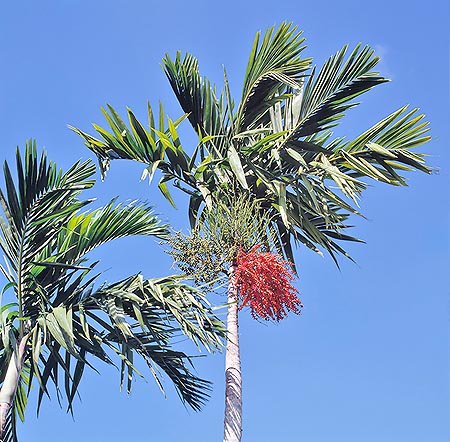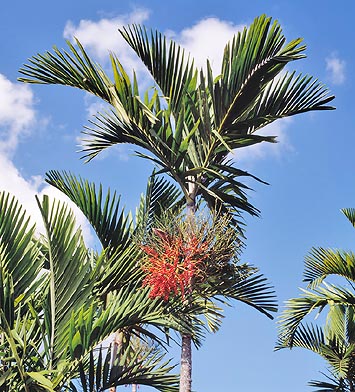Family : Arecaceae

Text © Pietro Puccio

English translation by Mario Beltramini

The Ptychosperma elegans is very frequent in the tropical gardens © Mazza
The name of the genus comes from the Greek ‘ptyché’ = fold and ‘sperma’ = semen, with a clear reference to the wrinkles present on the seed.
The name of the species is the Latin name “elegans” = elegant.
The names with which it is commonly known are: “cabbage palm”, “solitaire palm” (English); “palmier solitaire” (French); “palmera solitaria” (Spanish); Solitairepalme (German); “palmeira-solitaria” (Portuguese).
Plant with solitary trunk, of green colour in the younger part and greyish in the older one, which can reach the 15 metres of height with a diameter of 12 cm. The 8 to 10 elegantly arcuate leaves are pinnate, of glossy intense green, long up to 3 metres, with leaflets, long even 1 metre in the median part, cut obliquely and indented at the apex. The foliar base wraps entirely the stem for a length of 40-50 cm.
The inflorescence, long 1 metre, under the leaves, carries unisexual cream-green flowers disposed on the typical triad (a female flower between two male ones). The fruits are globose, 10-15 mm of length, of rec colour when ripe. It reproduces by seed which germinates in 2-3 months.

Ptychosperma elegans © Giuseppe Mazza
The plant is widely cultivated for its ornamental characteristics in the tropical and subtropical countries, both in full sun and in partial shade.
The cultivation in the warm-temperate ones may be tried as it resists for short periods, when adult and in well drained soils, also to rather low temperatures, around the 0 °C.
Because of its reduced size and its elegant look, the Ptychosperma elegans proves to be particularly suitable for its utilization in patios and in great open inner courts. It has a fairly good employment, in pot, for indoor decoration.
Synonyms: Seaforthia elegans R.Br. (1810); Archontophoenix elegans (R.Br.) F.M.Bailey (1890); Saguaster elegans (R.Br.) Kuntze (1891); Ptychosperma seaforthii Miq. (1855); Pinanga smithii W.Hill (1875); Ptychosperma capitis-yorki H.Wendl. & Drude (1875); Ptychosperma elegans var. sphaerocarpum Becc. (1885); Saguaster capitis-yorki (H.Wendl. & Drude) Kuntze (1891); Archontophoenix jardinei F.M.Bailey (1898); Ptychosperma jardinei (F.M.Bailey) F.M.Bailey (1909); Ptychosperma wendlandianum Burret (1927); Ptychosperma wendlandianum var. sphaerocarpum (Becc.) Burret (1927); Actinophloeus capitis-yorki (H.Wendl. & Drude) Burret (1928).
→ For general notions about ARECACEAE please click here.
